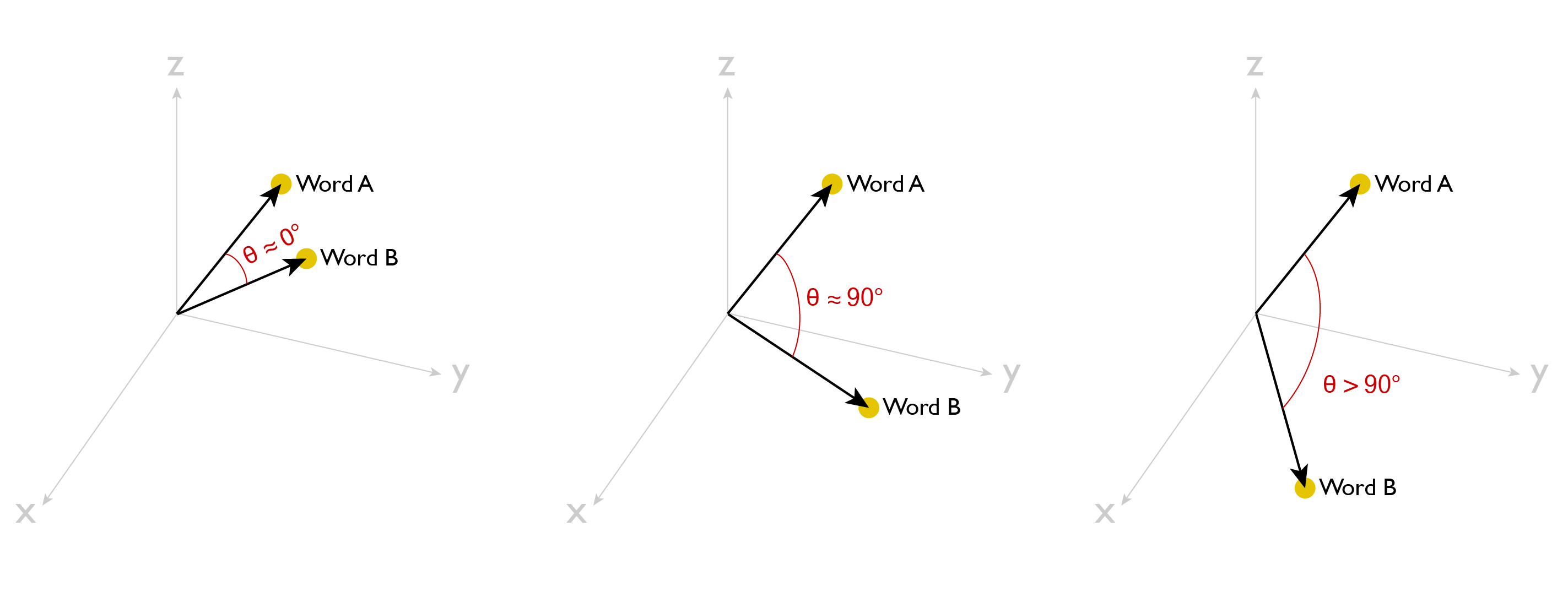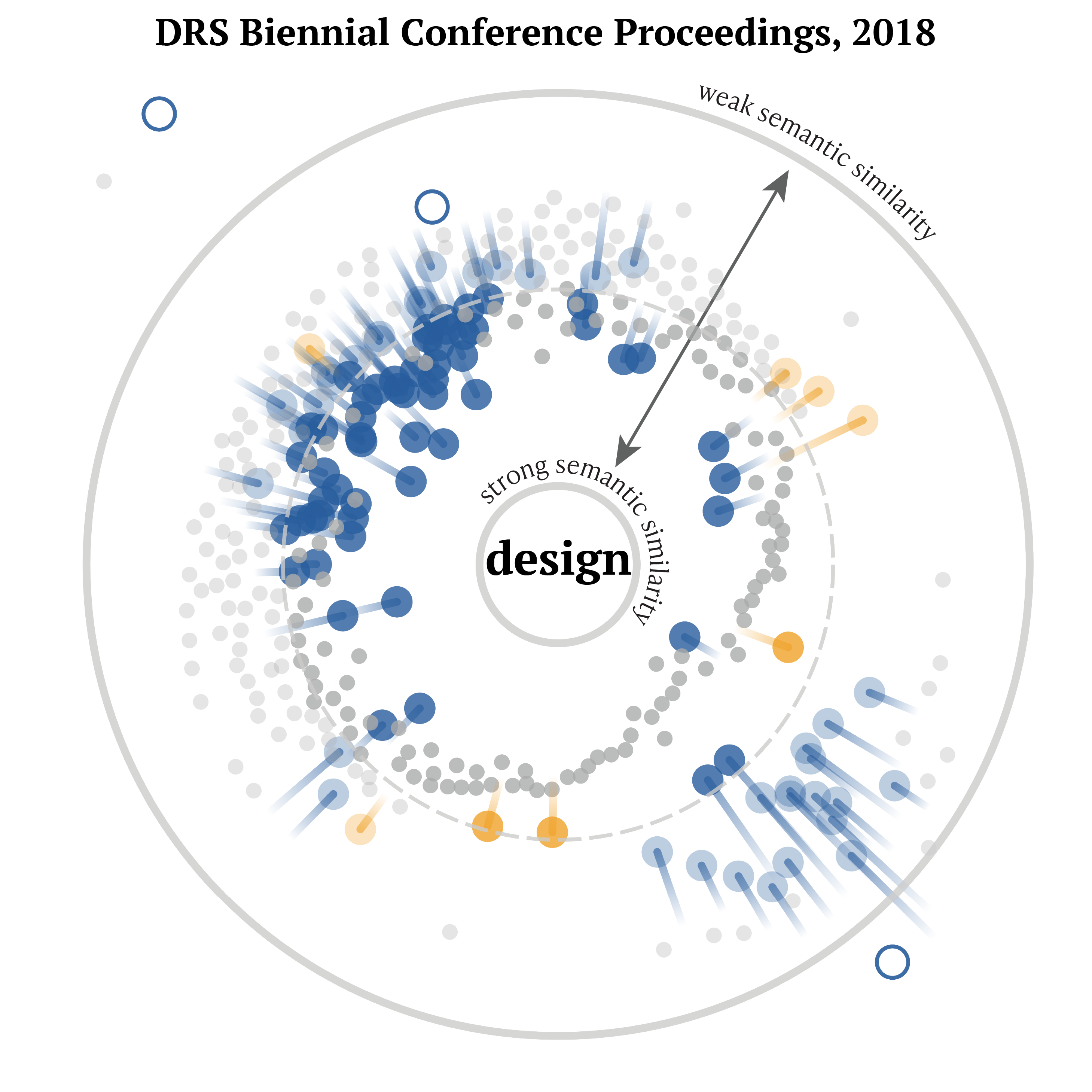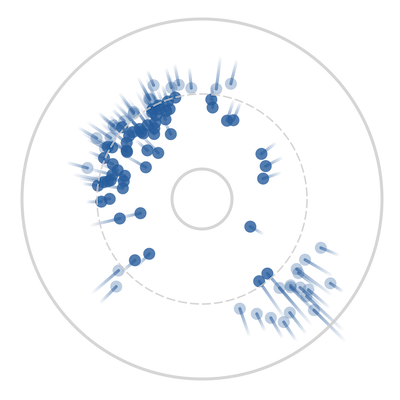when we talk about design

We encounter design in many kinds of spaces – public services, academic research, professional practice, and mass media. These spaces afford different lenses for understanding what we mean when we talk about design, whether that be the design of products and services, formal theory, or entertainment and culture. As we become more aware of the ubiquitous presence that design holds in our daily interactions with the world and one another, the language we use to articulate those encounters continues to evolve in tandem.
In reality, every time we talk about “design,” we tap into a web of words that conceals much more information than the sounds created by the sequence of its letters. Every utterance is an invocation – not of a single word whose definition can be found in a dictionary, but an entire vocabulary of semantic relationships whose meaning is shaped by every person who enters into dialogue with it. That vocabulary carries with itself a discursive history of how our linguistic orientation to design has changed over time, collected through the many other words that arise in the spaces between letters that never get spoken.
When we talk about design, we are also talking about research, method, process, and medium, even when these words never roll off our tongue; when we encounter design through interactions with products or services, we become silently entangled in a discourse of being, making, and knowing that continuously shifts through time.
What if we could capture a trace of that history, to map out a landscape of design language? This is one of the questions pursued by the Design Observatory, a research project at the Center for Design at Northeastern University. And one place to begin that investigation is academic design: how design is talked about in academic discourse, and how that discourse has changed over time.
Academic design discourse occurs predominantly in spaces of scholarly communication – academic conferences and journals. These serve as useful proxies for investigating how design is talked about in academic research. To start this analysis, the Design Observatory focused on conference proceedings from the Design Research Society (DRS), an international organization of scholars and practitioners committed to promoting and developing design research across disciplines and in education. The DRS hosts a Biennial Conference Series that brings together members of the international design community to discuss the methods and practice of design, yielding a historical record of themes, topics, and language of that discourse and how it has changed over time.
In 2021, DRS made available its Digital Library, an online database providing full-text access to DRS conference proceedings and publications. Using the full-text proceedings from the Design Research Society Biennial Conference Series made available through the DRS Digital Library, we began our investigation of discourse by focusing on individual words – the most frequently-used words in proceedings, and the frequency with which those words appear together. While focusing on individual words provides a basic metric of the kind of language used to talk about design, this approach offers an incomplete view of discourse. After all, when words are taken out of context, they can lose semantic nuance, where words’ meanings change from one context to another.
To reclaim these semantic associations between words, we shifted from analyzing individual words towards word vector analysis. In word vector analysis, each unique word used in a corpus is mapped to a location in a multidimensional semantic space. The position of each word is mathematically represented as a vector of semantic factors, where any single word contains different proportions of the meaning of other words.
The result of this mapping is a collection of relationships: some words are located in similar regions of space, while other words are located further away from one another. These relative positions encode semantic similarity between words, based on how they are used in the corpus. For example, the words “design” and “process” might be located close to one another, indicating they are used in semantically similar contexts, but “setting” might be located further away from these words, suggesting it is used in semantically different contexts.

The vectors that represent these positions in semantic space can be compared to one another to compute a measure of similarity. Specifically, the angle between the vectors can be used to calculate the cosine similarity between them. This cosine similarity ranges in value from -1, to 0, to 1. When the cosine similarity between two word vectors is 1, the words are perfectly semantically correlated (and used in the same semantic contexts); when the similarity is -1, the words are perfectly semantically uncorrelated (and used in opposite semantic contexts); and when similarity is 0, there is no semantic relationship between the words.

The visualization shown in the background here visualizes the most frequently-used words in DRS Biennial Conference Series proceedings – words like process, discipline, participatory, and education – and their semantic similarity to the word “design,” based on proceedings published between 2016 and 2020. The resulting visualization conveys the vocabulary around “design,” the collection of words that is invoked every time the discourse of design is engaged. Some words in that vocabulary are more closely related, by way of how frequently they appear in close proximity to discussions of design, such as approach, practice, or method. These are highlighted in green; the closer the word is to the center of the circle, the more strongly semantically related the word is to “design.”
Meanwhile, other words in that vocabulary are less closely related, such as understanding, meaning, or building. These words are highlighted in green; the further a word is away from the center, the more weakly semantically related the word is to “design.” But even if more distantly related, these words are not completely unrelated to design. Instead, they are just more weakly correlated. This is the advantage of word vector analysis: we begin to see design discourse as a collection of relationships, rather than a binary of included or excluded words.
The proceedings of the Design Research Society's Biennial Conference Series is just one proxy of academic discourses of design. If we examine other proxies, we can get a more complete picture of linguistic relationships. One such source is full text of articles in the Design Studies journal. Here, the same vocabulary of design is drawn, but now using the computed values of semantic similarity for words specifically in Design Studies. The set of most-similar words is almost identical to that of the DRS, but the Design Studies vocabulary features a stronger correlation for the word “tool”, and inversely, a weaker correlation for the word “education,” by comparison.
Let us return to the vocabulary for design in the proceedings of the DRS Biennial Conference. The vocabulary that is displayed here represents a rolling average semantic similarity for words in 2018, calculated by computing word vectors for the words displayed using conference proceedings between 2016 and 2020.
If we change the window of time for our analysis, we can begin to see how that vocabulary has changed over time. Here, the position of words shows average semantic similarity for those words in 2004, computed using conference proceedings from the DRS Biennial Conference between 2002 and 2006.
By comparing the semantic similarity of words in the vocabulary from 2004 to the semantic similarity of those same words in 2018, we can see the degree to which words have become more strongly or more weakly correlated with “design.”
If we color these arrows, we begin to see a global visual record of change in the shape of that vocabulary over time. Some words show change in similarity between 2004 and 2018, but that change is too small to be indicative of a significant shift in semantic relationship; these arrows are colored gray. Meanwhile, those words that do suggest significant shift can either represent a positive change, or increase in semantic similarity between 2004 and 2018 (colored blue), or they can represent a negative change, or decrease in semantic similarity (colored orange).
From this, we can see that the vocabulary around “design” consists primarily of insignificant semantic similarity shifts over time, i.e., mostly gray arrows. After that, there is a small cluster of words that have increased in similarity, and an even smaller cluster of words that have decreased in similarity. Together, these observations suggest that the vocabulary of design has stayed relatively stable between 2004 and 2018.
The apparent (in)stability of words in a vocabulary, along with the overall degree of semantic correlation across those words, offers a measure of discursive change. When a vocabulary is tightly-correlated, meaning words in the vocabulary have high similarity to the core term, this suggests that the term is talked about consistently and in the same way, in the same kinds of contexts. In other words, when we talk about “design” in the DRS conference proceedings, we are also highly likely to be talking about “process,” “method,” and “research.” The co-occurrence of these terms will be predictable. When the relative tightness of this correlation does not change much over time, this suggests that the vocabulary has remained stable over time. In contrast, a more weakly-correlated vocabulary suggests less consistency or agreement on what words are part of the vocabulary, and greater variation in the kinds of semantic contexts in which a term is used. The words in a tightly-correlated vocabulary yield a vocabulary that is low in entropy, stable, and more difficult to disrupt; a weakly-correlated vocabulary is one with higher entropy, possessing greater potential to shape-shift in different directions.
We can repeat this procedure for any other word in the overall vocabulary. For example, we can investigate the change in the vocabulary around “process” over time. In contrast to design, the vocabulary around process shows a large amount of change over time, primarily of words becoming more semantically similar to “process.” The vocabulary appears to move from a state of higher to lower entropy over time, suggesting a stabilizing vocabulary.
Here, we see the change in the vocabulary around “data” over time. Like what is seen for process, there is a large amount of increases in semantic similarity. But even so, these words are further away from the center, indicating weaker overall similarity. The result is a vocabulary that is high in entropy, with potential for shifting in many directions. These observations suggest that the vocabulary around data is still developing, which seems reasonable given the relatively recent emerge of data-oriented methods and practices in design.
The visualizations below explore these kinds of changes in academic discourses of design, through semantic analysis of the vocabulary of the highest-frequency words in the DRS Biennial Conference Series and Design Studies journal. To be part of the conversation of design is to continuously push that discourse in new directions, changing the vocabularies that prescribe what design is, means, and could mean in the future. If we situate ourselves as practitioners, scholars, and consumers of design within those vocabularies, an entire landscape of discourse reveals itself – and it is perhaps in its regions of greatest semantic entropy, instability, and indeterminacy that we will find the future of design unfolding in real time.



